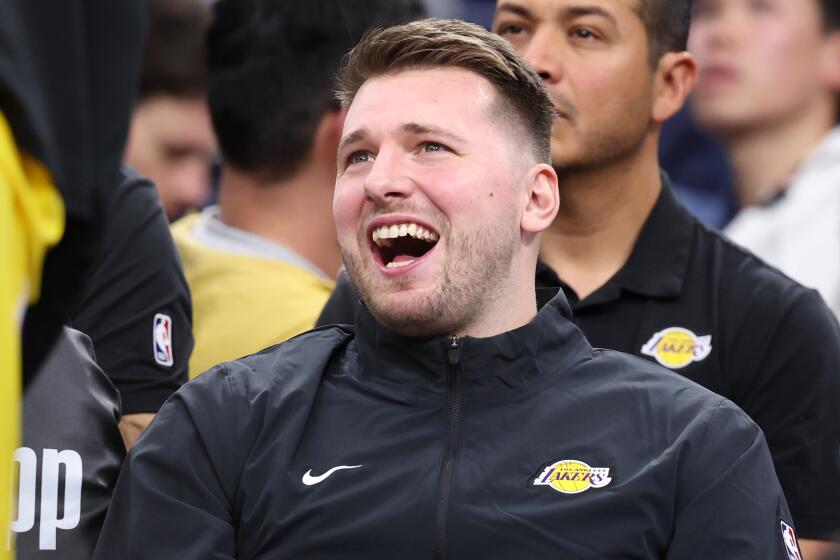Familiar Open Forecast: Groans and Moans
- Share via
The pros are going to try on their U.S. Open game faces pretty soon and Tom Meeks already knows what they’re going to look like. Sourpusses.
Meeks is the senior director of rules and competitions for the U.S. Golf Assn., which makes him the guy responsible for the setup of next month’s U.S. Open at Shinnecock Hills Golf Club on the far eastern edge of Long Island. His job also makes Meeks the first target for anybody who hasn’t gotten used to the typical U.S. Open course setup, which apparently many haven’t.
In more than 30 years with the USGA, Meeks has discerned a conditioned response from players at the Open. It includes whining and complaining, but also features groaning and moaning, he said. Some players are so adroit at criticizing the Open setup, Meeks said, they start their complaining before they drive into the parking lot at the course.
Meeks said the negative comments he hears aren’t as bad as they used to be, which means that either the players have adjusted or the courses are no longer as tough.
That’s not going to be Shinnecock.
If the wind blows, more than a few players are going to be signing their scorecards in blood.
So consider this an early warning. Shinnecock is going to have all the elements of design that we have come to expect of U.S. Open layouts or that new elevator ride at Disney’s California Adventure. You know the drill: narrow fairways, gnarly rough, greens harder than a 75-cent steak, and watch that first step.
They measured the place and said it comes out to only 6,996 yards, which makes Shinnecock, which has hosted the Open in 1986 and 1995, the shortest of the four major venues this year, and way behind the 7,590-yard behemoth of Whistling Straits for the PGA Championship.
There are new tees at the third, fourth and seventh holes at Shinnecock, giving the potential of another 30 yards in distance at every one. But the USGA also shortened the par-three 17th by eight or 10 yards.
And to make sure the elements get their chance to wreak havoc, a hedge to the right of the seventh tee and one behind the third green were yanked out of the ground so the wind would have an unblocked path.
That’s a wonderful touch, perfectly in keeping with typically diabolical U.S. Open courses. Who can forget the 10th hole at Bethpage Black in 2002 when the wind and rain were blowing right in the golfers’ faces as they stood at the tee and contemplated a shot that required about 280 yards in carry just to reach the fairway?
Meeks promises that Shinnecock’s greens will be firm and fast, but fair. He also vows that the rough isn’t going to be that high, probably no more than 4 1/2 inches. No sense in turning the Open into a lost ball contest, he said.
As for any surprises, Meeks scoffed. He said the USGA wasn’t in the business of springing surprises.
It’s doubtful that will console the players who discover the roll-off areas at such holes as the ninth and 10th, where some unfortunate golf balls will roll back as much as 50 yards off the green.
Then there is the 155-yard par-three 11th. Meeks calls it the hardest short par-three in golf because the elevated green is small and it’s surrounded by trouble.
He said the 11th is going to be a fun hole to watch. Whether it’s a fun hole to play, that’s a different matter, and certainly not Meeks’ problem.
This U.S. Open is going to be one of the best ever, Meeks said. Pinehurst, Pebble Beach and Bethpage were a total blast recently, but Meeks says he believes Shinnecock will turn out to be tops.
The reason, Meeks says, is because he believes the winning score will be over par. In the two other U.S. Opens at Shinnecock, Raymond Floyd’s one-under was good enough to win in 1986 and Corey Pavin won at even par 280 in 1995.
Meeks feels pretty sure about his prediction because the fairways are going to be about 26 yards wide on most holes. The pros probably aren’t going to like that too much because they’re used to fairways you could land jumbo jets on.
But the USGA has its reasons for keeping the fairways narrow at the U.S. Open. If there is anything you ought to already know about the Open and the USGA is that they don’t want to make it easy.
Actually, about the only thing Meeks is concerned about is keeping the greens dry, hard and fast enough that players can still actually putt the ball, but not so dry and hard and fast that balls will roll away if the wind kicks up. That would be a travesty, he said. Others might say it wouldn’t be a real U.S. Open without it. Sourpusses.
More to Read
Go beyond the scoreboard
Get the latest on L.A.'s teams in the daily Sports Report newsletter.
You may occasionally receive promotional content from the Los Angeles Times.










